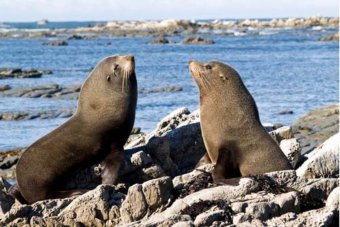OIL RIGS and artificial reefs may be playing a vital role in feeding fur seals — one of Australia’s largest sea creatures and still recovering from centuries of hunting by humans, new research by Deakin scientists has found.
Researchers from Deakin’s Centre for Integrative Ecology within the School of Life and Environmental Sciences teamed up with National Geographic, the University of Tasmania and University of California Santa Cruz to investigate the feeding behaviour of the Australian fur seals in Bass Strait.
Associate Professor John Arnould said some seals carrying National Geographic “crittercams” revealed they and other individuals congregated around human-made structures which act as artificial reefs attracting fish.
“These findings mean that man-made structures such as pipelines, cable routes, wells and shipwrecks could play a vital role in helping to improve the recovery rates of our fur seals,” he said.
“The Australian fur seal population is increasing at just 2 per cent a year and still sit at population levels below 60 per cent of what it was before the commercial sealing era in the 18th and 19th centuries.”
The researchers tracked the foraging patterns of 36 Australian fur seals from Kanowna Island in Bass Strait, using GPS loggers and dive recorders.
The research is published in the latest edition of science journal PLOS One.
“While we know fish congregate around these structures, scientists don’t know a lot about their use by marine mammals and we were surprised at first to find the Australian fur seals were going to these area,” Associate Professor Arnould said.
“We found that 72 per cent of the 36 seals we tracked spent time around the man-made structures, with pipelines and cable routes being the most frequented. More than a third of animals foraged near more than one type of structure.”
Associate Professor Arnould said man-made changes to natural habitats could often have negative effects on animals which lived in the regions surrounding them, including a reduction in foraging habitat, breeding sites and refuge from predators.
“Some species, however, can adapt to, and even benefit from, changes to their habitats,” he said.
“Indeed, man-made structures can provide a range of benefits for some species, from predator avoidance, thermoregulation, and breeding sites, to acting as important foraging areas.”
Associate Professor Arnould said seals and sea lions around the world had experienced variable rates of population recovery since the end of the sealing era.
“We have seen species that feed close to the surface have experienced rapid growth in numbers, populations of species that feed on the ocean floor, such as the Australian fur seal, have increased very slowly, are stable or in decline,” he said.
“It has been suggested that the low population recovery rates of these species could be due to them hunting in environments which for decades have been the focus of commercial fisheries using bottom trawlers that disrupt the habitat and remove the larger size-classes of species that the seals depend on for food.
“The Australian fur seal feeds exclusively on the sea floor of the continental shelf on a wide variety of fish, octopus and squid species.”
Associate Professor Arnould said all but one of the Australian fur seal’s breeding colonies occurred on islands within Bass Strait, between the Australian mainland and Tasmania, which has an average depth of 60 metres and is considered to be a region of low food availability for marine predators.
“Therefore, structures like oil and gas rigs and pipelines that occur on the relatively featureless sea floor could provide a valuable prey habitat and promote foraging success for the species,” he said.
Get the latest news to your email inbox FREE!
REGISTER






